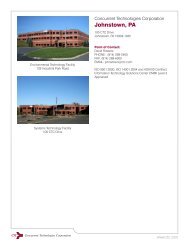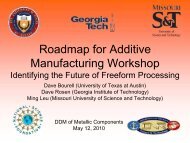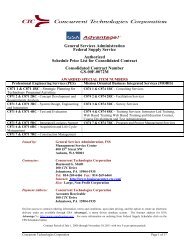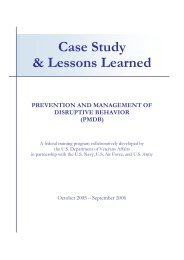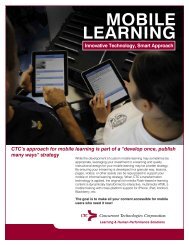Information Security Warfare Systems - CTC Bremerton Instructional ...
Information Security Warfare Systems - CTC Bremerton Instructional ...
Information Security Warfare Systems - CTC Bremerton Instructional ...
Create successful ePaper yourself
Turn your PDF publications into a flip-book with our unique Google optimized e-Paper software.
ADL SCORM 2004 Demonstration: ISWS Course Conversion Lessons Learned<br />
11. Content-free prototypes provide value by creating efficiencies in the development of new<br />
sequencing strategies.<br />
The project team decided to create a content-free prototype to test the SCORM 2004 manifest.<br />
The addition of sequencing added a great deal of complexity and it was desirable to separate it<br />
initially from the content. Thus, content-free placeholders were used in the initial versions of the<br />
product.<br />
The process turned out to be very practical and resulted in a number of efficiencies. First of all,<br />
it allowed the developers to focus on the manifest without complications from the content. A<br />
side effect was a reduction in the learning time for sequencing and navigation. Because the<br />
content-free SCOs and Assets were simple html pages, there was also a significant reduction in<br />
the development time required for testing and quality assurance. Once the content was added,<br />
the testing and quality assurance time associated with the manifest increased dramatically.<br />
The manifest is a reflection of the instructional design in the activity tree. That being noted, if an<br />
organization develops sequencing models, the benefits of content-free prototypes would diminish<br />
as bugs are worked out of the system. Those who choose to work with content-free prototypes<br />
should also allow for sufficient testing of the product with the content, which can have its own<br />
issues.<br />
12. <strong>Instructional</strong> designers and developers can work in parallel.<br />
Once the initial course structure is created, and the sequencing strategy defined, it’s possible for<br />
instructional designers and developers to start working in parallel. For example, while<br />
instructional designers are writing the content, developers can be developing the manifest and<br />
creating and testing a content-free prototype.<br />
13. Navigation is no longer entirely at the discretion of the development team, and<br />
consideration must be taken to ensure learners have a satisfying experience.<br />
SCORM 2004 has a significant impact on end users, compared to previous versions where<br />
SCORM was relatively transparent to the learner. Historically, developers of computer-based<br />
training have designed and controlled the way in which a learner navigates through a course.<br />
With sequencing and SCORM 2004, much of the navigation is controlled by the LMS. SCORM<br />
does not define how this is to be done, and so the same training may be displayed very<br />
differently in different LMSs. It is reasonable to predict that navigational standards will be<br />
developed in the future, but until that time, developers of SCORM conformant courses must pay<br />
particular attention to navigational issues to ensure the learners both context and a smooth<br />
navigational experience. If teams are developing to a known and familiar LMS(s), this could be<br />
relatively simple. It will grow more complex as the number of LMSs to be designed for<br />
increases, or when content must be designed but the LMS is unknown.<br />
Conversion of pre-existing content may require a retrofit of navigation in order to prevent learner<br />
confusion. An objective of this particular conversion was to minimize alterations to the original<br />
content. This resulted in two navigational schemes: the one already incorporated into the SCOs,<br />
<strong>CTC</strong> <strong>Bremerton</strong>, May 14, 2004 8



